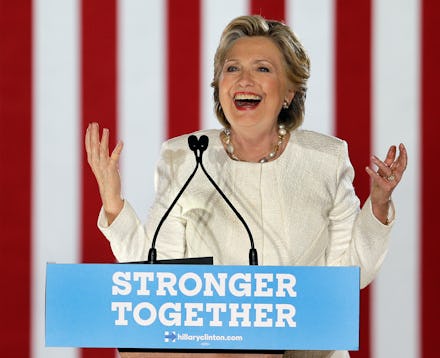Panicking Democrats should calm the hell down about Hillary Clinton's chances. Here's why.

A Donald Trump presidency looks considerably more plausible than it did just a few days ago, before FBI Director James Comey jolted the presidential race with a cryptic letter to Congress announcing that the bureau was reviewing new evidence linked to Hillary Clinton's email server.
Clinton's national lead in the RealClearPolitics average — a solid seven points two weeks ago — has tumbled to about two points, while state-level surveys show Trump narrowing his gap with Clinton in the Electoral College. Enthusiasm for Clinton's candidacy lags well behind the fervor that fueled President Barack Obama's re-election four years ago, particularly among black voters, whose early voting rates have dipped in key states.
The reasons for mounting Democratic anxiety are obvious. (From Clinton's perspective, that anxiety could actually be a boon, given the campaign's earlier worries that her strong lead was fostering a sense of complacency.) But full-fledged panic is not in order — and there are four big reasons for Democrats to remain confident that, after sifting through the sound and the fury of the campaign news cycle, the fundamentals of Clinton's candidacy remain strong.
Clinton's support isn't really collapsing
While Clinton's margin is shrinking in national polls, her support is holding more or less steady.
At her mid-October peak, she garnered 46.2% support in a four-way race in the RealClearPolitics average while Trump languished at 39.1%.
Since then, Trump has consolidated Republican support — likely thanks to fallout from negative headlines about rising premiums under the Affordable Care Act and the FBI email review, as well as partisans' natural coming home in the final days of an election cycle. He's now averaging 43.4% support, while Clinton stands at 45.3% — less than a percentage point down from her best polling average in the four-way race.
Trump, who has struggled to break out of the mid-40s in the face of sky-high unfavorable ratings and the widespread view that he's not qualified to be president, will have a difficult time growing his support further.
"Trump remains historically weak among nonwhite voters and college-educated white voters, weaknesses that are particularly pronounced in the swing states. That's been true for the entirety of this cycle," Democratic strategist Matt McDermott said.
Clinton is building a strong lead in early voting
Even before Comey dropped his Friday bombshell, millions of Americans had already taken advantage of early voting, limiting Trump's ability to capitalize on the news.
And early voting trends point to a good night for Clinton on Nov. 8.
In Nevada — where some recent polls suggest she is effectively tied with Trump or even a bit behind him — early voting data indicates that Clinton has built an early lead on the scale of Obama's in 2012, when he defeated GOP nominee Mitt Romney in the state by nearly seven percentage points. Veteran Nevada political analyst Jon Ralston said that Democrats' advantage in early voting is placing the state increasingly out of reach for Trump.
In North Carolina, meanwhile, the data-crunchers at the Upshot calculate that early voting trends suggest a Clinton victory by roughly six percentage points on Election Day.
While Clinton can afford to lose in Nevada and North Carolina, Trump's path to the White House will be closed off entirely if he loses both.
Swing state polls show how narrow Trump's path remains
Therein lies the rub for Trump. While he has a plausible road to 270 electoral votes, it's incredibly narrow, requiring him to virtually run the table in key battleground states.
Say Trump wins Ohio, Iowa, Arizona, Maine's second congressional district and Florida, where the two latest polls show Clinton with a small lead. Then assume he overcomes early voting trends to defeat Clinton in Nevada and North Carolina. That generous scenario still leaves Clinton with 272 electoral votes to Trump's 266 — meaning Trump would also need to pick off a state like New Hampshire, where he's behind by about five points; Colorado, where Clinton maintains a small lead and has seen encouraging trends in early voting; or Pennsylvania, where Clinton led in three new polls released Wednesday and is ahead by about five points on average. Trump's best polls in the Keystone State show him at about 44% support, while Clinton tends to hover in the upper 40s.
What's more, a Marquette University poll out of Wisconsin on Wednesday indicates that fears Trump could pick off traditionally blue states are likely overblown. Clinton led Trump 46% to 40% in the Badger State, where Trump has never broken out of the low 40s in public polling. A post-Comey poll of Michigan, meanwhile, brought similar good news for Democrats, with Clinton boasting a seven-point lead.
Not only does Trump need to be doing better than he is in traditional swing states, but he also has to worry about hanging onto GOP strongholds like Utah, where polls point to a toss-up among Trump, Clinton and independent Evan McMullin, and Alaska, where two recent polls show Clinton ahead and others peg Trump's lead in the low single digits.
So while it was to be expected that many Democrats would freak out at the news that Clinton is going up on the air in blue states like Wisconsin and Michigan, there's actually more data to back up the idea that Trump should have to worry about Utah and Alaska than that Clinton should be clutching her pearls about winning the Upper Midwest.
Another shoe could drop with Trump.
On that note: A woman who alleges that Donald Trump raped her when she was 13 is set to speak publicly about the incident for the first time on Wednesday evening.